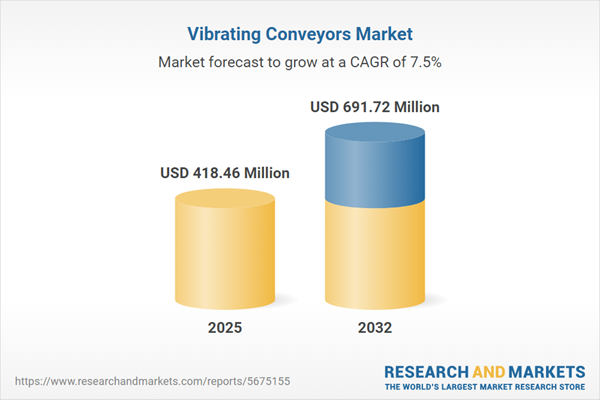Speak directly to the analyst to clarify any post sales queries you may have.
The global vibrating conveyors market is gaining traction as organizations prioritize automation, regulatory compliance, and adaptable material handling. Senior decision-makers are deploying intelligent conveyor systems to amplify efficiency and secure operational resilience in modern manufacturing environments.
Market Snapshot: Vibrating Conveyors Market Size and Growth
The vibrating conveyors market is positioned for substantial expansion, driven by persistent investment in industrial automation and increasing digital integration throughout production networks. As businesses modernize operations, smart conveyor technology is becoming a central pillar for boosting throughput and maintaining stringent quality assurance. Critical need for advanced, hygienic conveyor equipment is most evident in food processing and pharmaceuticals, where demanding sanitation standards and regulatory compliance dominate procurement strategies. In this evolving landscape, suppliers are introducing solutions designed to support round-the-clock material flow, meeting growing industry expectations for continuity and reliability.
Scope & Segmentation: Strategic Market Understanding
This report offers targeted segmentation designed for senior executives aiming to drive strategic clarity and effective planning. Each segment highlights priorities for operational and technology adoption across major regions and sectors.
- End Use Industry: Details utilization of vibrating conveyors within chemicals, pharmaceuticals, food and beverage, metal fabrication, automotive, mining, aggregates, packaging, and logistics to promote safety, enhance productivity, and meet compliance requirements.
- Conveyor Type: Outlines leading applications for ball tray, linear, reciprocating, and tubular vibrating conveyors in varying facility layouts and material transport settings.
- Drive Type: Examines strategic roles for electromagnetic, mechanical, and pneumatic drives in optimizing material flow, ensuring reliable results, and reducing operational noise in diverse production environments.
- Capacity Range: Evaluates options ranging from compact, precision-focused conveyor systems optimized for small plants to high-capacity automated conveyors for demanding, large-scale operations.
- Regional Coverage: Explores trends across the Americas, Europe, Middle East & Africa, and Asia-Pacific, highlighting each region’s infrastructure, compliance drivers, and unique adoption challenges.
- Company Analysis: Reviews the positioning and influence of major suppliers such as General Kinematics LLC, TerraSource Global, NETZSCH Pumpen & Systeme GmbH, Martin Sprocket & Gear, Hawkins International, FLEX-MOR Conveyors, Kason Corporation, Kirloskar Brothers, Thyssenkrupp Polysius, and Hosokawa Alpine Aktiengesellschaft.
Key Takeaways for Senior Decision-Makers
- Businesses are sharpening their approach to precision material handling, addressing compliance and hygiene for sectors with sensitive production standards.
- Deployment of digital monitoring allows for predictive maintenance, leading to heightened uptime and lower unplanned stoppages on manufacturing lines.
- Adaptable and modular conveyor architecture now supports agile auditing, tracking, and documentation for compliance in heavily regulated manufacturing segments.
- Incorporating energy-efficient components helps organizations address operational cost management and contributes to ongoing sustainability initiatives across processing industries.
- Contemporary conveyor solutions enable facilities to adjust rapidly to evolving manufacturing demands, accommodating everything from mining and extraction to fast-paced consumer packaging lines.
United States Tariff Impact: Navigating Supply Chain Changes
Recent changes to U.S. tariffs on industrial and automation equipment are prompting manufacturers to reassess sourcing and reinforce local supply chain resilience. Flexible partnerships and adaptive sourcing strategies are now critical. Leading organizations are embracing new materials and streamlined manufacturing methods to help stakeholders manage cost fluctuations and regulatory changes efficiently.
Methodology & Data Sources
This analysis combines in-depth secondary research with direct insights from conveyor suppliers and logistics professionals. The report draws on proprietary datasets, detailed corporate filings, global trade records, and scenario modeling to inform actionable recommendations.
Why This Report Matters: Vibrating Conveyors Market Strategic Insights
- Presents precise segmentation and in-depth regional trend analysis, supporting robust resource planning and informed executive investments.
- Delivers clear regulatory and sustainability guidance to reduce compliance exposure and operational risk for manufacturing leadership teams.
- Equips decision-makers to anticipate and manage dynamic supply chain disruption as sourcing frameworks evolve in the vibrating conveyors market.
Conclusion
This report equips senior executives with concise insights to inform confident investment, strengthen compliance, and enhance operational adaptability in today’s rapidly evolving vibrating conveyors sector.
Additional Product Information:
- Purchase of this report includes 1 year online access with quarterly updates.
- This report can be updated on request. Please contact our Customer Experience team using the Ask a Question widget on our website.
Table of Contents
3. Executive Summary
4. Market Overview
7. Cumulative Impact of Artificial Intelligence 2025
Companies Mentioned
The companies profiled in this Vibrating Conveyors market report include:- General Kinematics LLC
- TerraSource Global, Inc.
- NETZSCH Pumpen & Systeme GmbH
- Martin Sprocket & Gear, Inc.
- Hawkins International Ltd
- FLEX-MOR Conveyors, Inc.
- Kason Corporation
- Kirloskar Brothers Limited
- Thyssenkrupp Polysius GmbH
- Hosokawa Alpine Aktiengesellschaft
Table Information
| Report Attribute | Details |
|---|---|
| No. of Pages | 195 |
| Published | October 2025 |
| Forecast Period | 2025 - 2032 |
| Estimated Market Value ( USD | $ 418.46 Million |
| Forecasted Market Value ( USD | $ 691.72 Million |
| Compound Annual Growth Rate | 7.4% |
| Regions Covered | Global |
| No. of Companies Mentioned | 11 |









